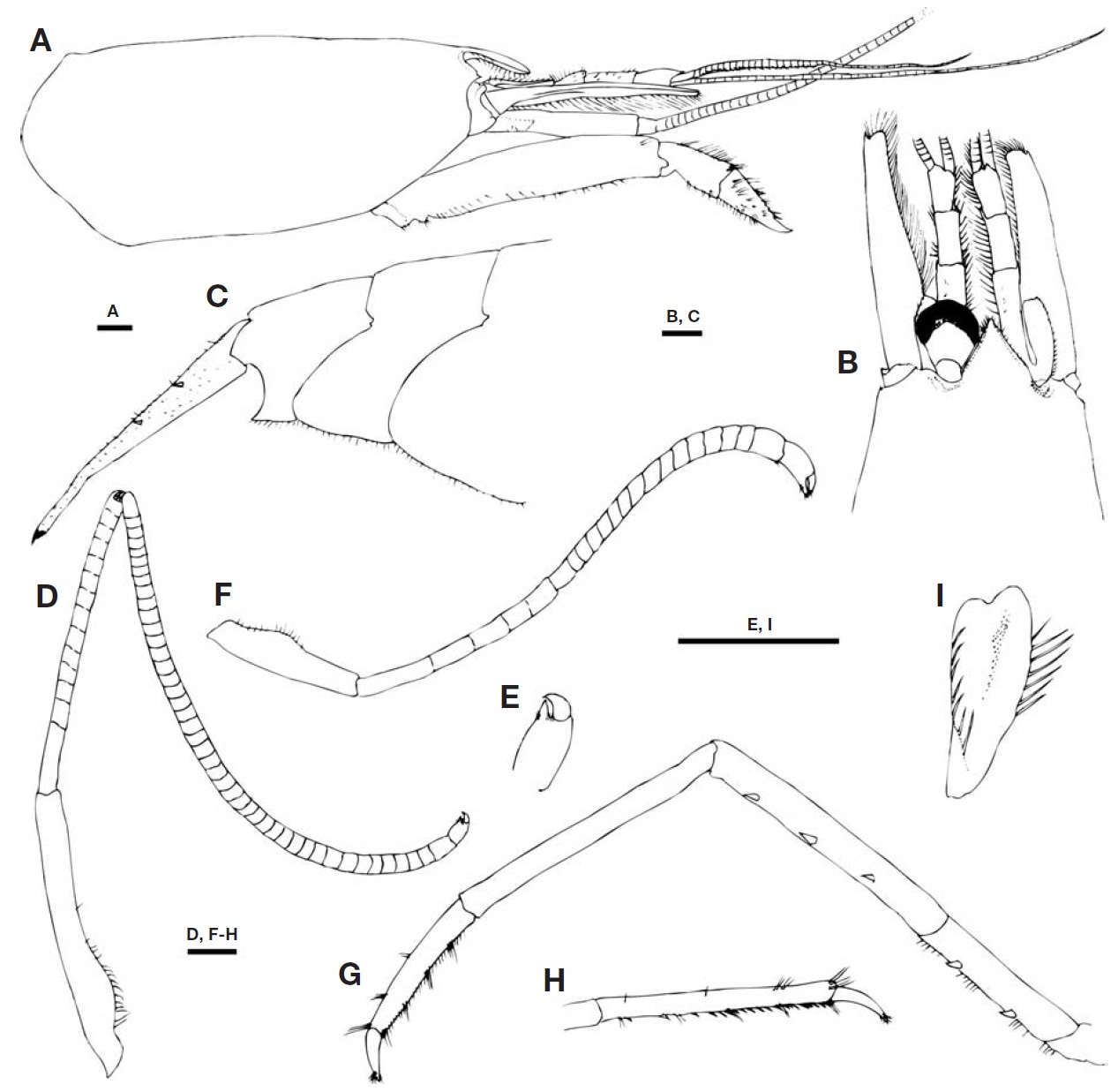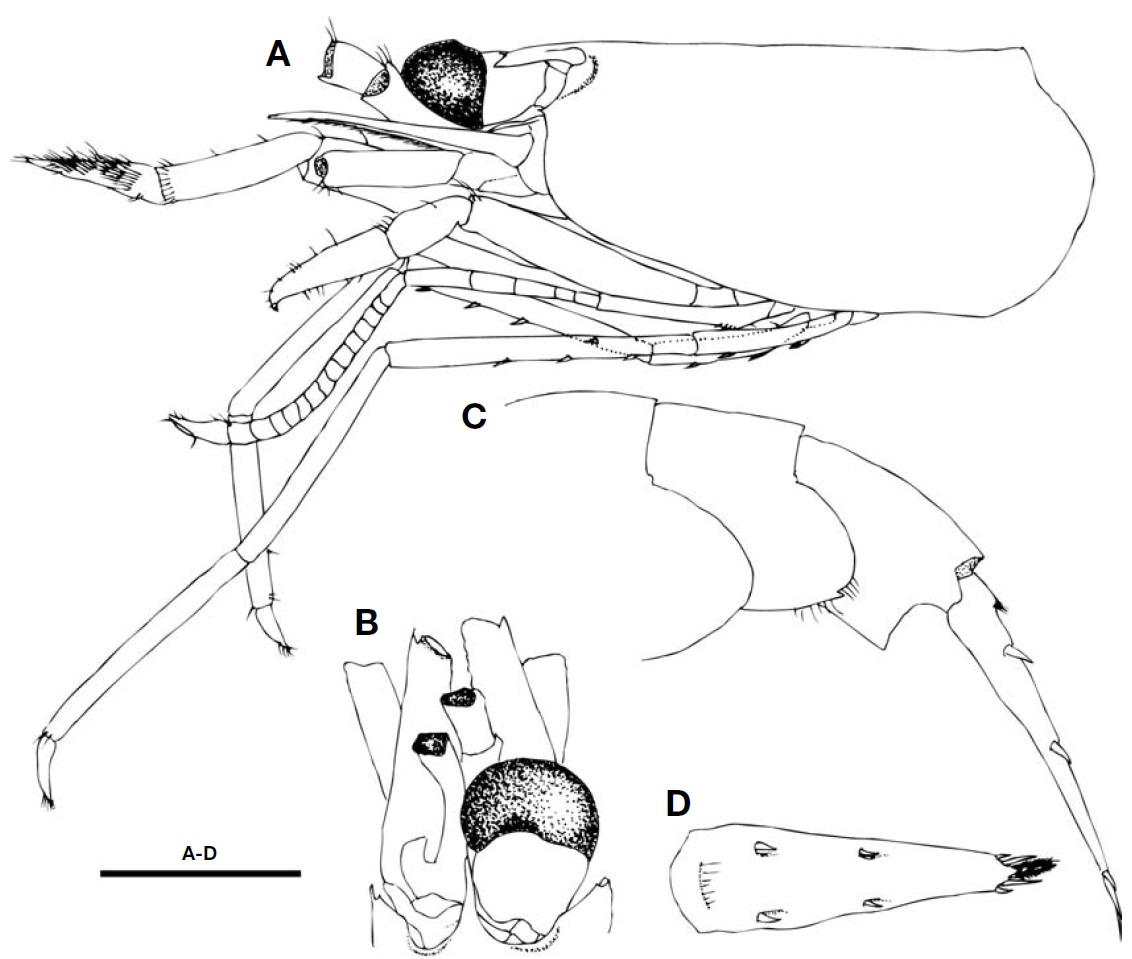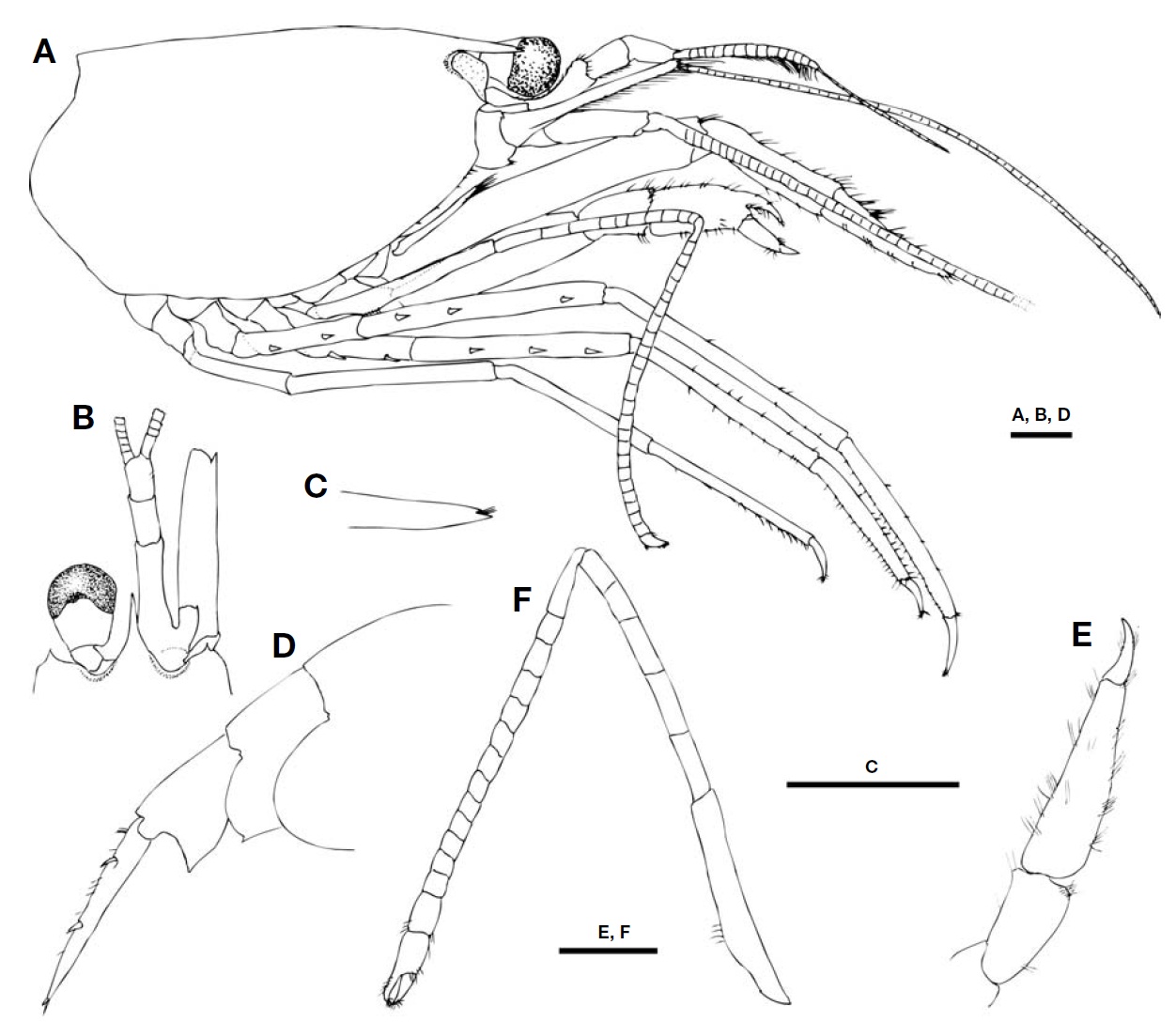



The family Processidae is characterized by a chelate right first pereopod and a simple left pereopod usually terminating in a plain claw-like dactylus. If both first pereopods are che-late, the rostrum shows a distal setose notch formed by a sub-distal dorsal tooth with no other teeth (Holthuis, 1993). The processid shrimps commonly occur in pantropical and sub-tropical regions and occasionally in temperate regions. They are usually confined to shallow grass flats and tide pools (Chace, 1997).
The family includes five genera and 65 species (De Grave et al., 2009). Only one,
During the course of a taxonomic study of Korean deca-pod crustaceans, three species of Processidae,
The specimens described in this study were deposited in the National Fisheries Research and Development Institute (NFRDI). Specimen sizes are based on postorbital carapace length (CL), and the terminology of the descriptions mainly follows that of Chace (1997).
Order Decapoda Latreille, 1802
Infraorder Caridea Dana, 1852
Family Processidae Ortmann, 1896
1*Genus Hayashidonus Chace, 1997
2*Hayashidonus japonicus (De Haan, 1844) (Fig.1 )
Restricted synonymy
synonymy); Noel, 1986: 287.
Material examined. Korea: Gyeongsangnam-do: 2♀♀ (CL 11.5, 11.8 mm), 1 ovig. ♀ (CL 12.2 mm), Namhae Island, Aenggang Bay, Zostera belt, beam trawl, 19 May 2005, Kim HW, NFRDI 20110802-1; Jeju-do: 1♂ (CL 6.8 mm), Hamduok, Zostera belt, beam trawl, 10 Jun 1994, Kim JN, NFRDI 20110802-2.
Description. Integument glabrous, except for pubescent tel-son. Rostrum (Fig.1 A, B) short, 0.17-0.23 times as long as carapace, broad, triangular in dorsal aspect, not bifid distally, lateral margin rather strongly carinate. Carapace (Fig.1 A, B) almost smooth; postorbital region slightly grooved; antennal spine small but acute. Abdominal somites (Fig.1 C) smooth and rounded; pleura of first to fifth somites unarmed; lateral
lobe of sixth somite triangular but not spiniform. Telson (Fig.1C) with 2 pairs of small dorsolateral spines; posterior mar-gin ending in minute median tooth, bearing 2 pairs of margi-nal spines and tuft of mesial setae. Eye (Fig.1 B) pyriform;cornea broader than eyestalk. Antennular peduncle (Fig.1 A, B) with first segment as long as distal 2 segments combined; second segment slightly longer than third; stylocerite trun-cate, reaching distal 1/3 of first segment of antennular pedun-cle. Antennal scale (Fig.1 A, B) overreaching distal margin of antennular peduncle; distolateral tooth falling short of blade; basicerite unarmed. Third maxilliped (Fig.1 A) stout, over-reaching distal margin of antennular peduncle by distal 2 seg-ments, without exopod; ultimate segment tapering to strong terminal tooth. First pereopods stout, asymmetrical; right che-late; left with simple dactylus, more slender than right. Sec-ond pereopods (Fig.1 D-F) slender, right longer than left; right (Fig.1 D) with 13-17 meral articles, 44-48 carpal articles, chela (Fig.1 E) with curved dactylus; left (Fig.1F) with 5-7 meral articles, 16-18 carpal articles. Third and fourth pereo-pods (Fig.1 G) with ischia bearing 2 spines; meri with 1-3 spines; propodi with series of short setae in flexor margin, some tuft of long setae in margins of both of flexor and exten-sor. Fourth pereopod longer than third. Fifth pereopod (Fig.1H) with propodus bearing 25 small spines in flexor margin.Endopod of first male pleopod (Fig.1 I) with distal margin notched, lateral and mesial margins with 6-7 stout setae.
Distribution. Indo-West Pacific: eastern Africa to Japan, Philippines, Indonesia, Korea (present study); to a depth of 150m (Chace, 1997).
Remarks. Chace (1997) established a new genus
unusual among the processids. The present specimens agree well with the definitions of the species by Chace (1997) and Hayashi (1975) who magnificently reviewed the Indo-West Pacific Processidae.
Genus Processa Leach, 1815
Processa sulcata Hayashi, 1975 (Fig.2 )
Restricted synonymy
Material examined. Korea: Gyeongsangnam-do: sex un-known 2 specimens (CL 2.5, 3.0 mm), Geoje Island, Gujora, rough sand, dredge, 1 Nov 2001, Kim JN, NFRDI 20110802-3.
Description. Integument glabrous. Rostrum (Fig.2 A, B) rela-tively long, 0.21-0.25 times as long as carapace, slender in dorsal aspect, bifid distally, ventral margin slightly concave. Carapace (Fig.2 A, B) nearly smooth; postorbital region dis-tinctly grooved; antennal spine distinct. Abdominal somites (Fig.2 C) smooth and rounded dorsally; pleura of first to fourth somites rounded posteriorly; pleuron of fifth somite with small posterior tooth; lateral lobe of sixth somite sub-truncated. Telson (Fig.2 C, D) with 2 pairs of distinct dorso-lateral spines; posterior margin ending in median tooth flank-ed by 2 pairs of spines and pair of setae. Eye (Fig.2 A, B) large; cornea moderately broader than eyestalk. Antennular peduncle (Fig.2 A, B) with distal segment of right and distal 2 segments of left missing; stylocerite obliquely truncate,falling short of midpoint of first segment of antennular ped-uncle. Antennal scale (Fig.2 A, B) with distolateral tooth not reaching blade; basicerite with smooth ventral margin. Third maxilliped (Fig.2 A) stout, overreaching distal margin of antennal scale by ultimate segment and distal 3/4 of penulti-mate segment, bearing well developed exopod. First pereo-pods (Fig.2 A) stout, asymmetrical; right with well develop-ed chela, stouter than left; left simple, with claw-like dacty-lus.Second pereopods (Fig.2 A) slender; right missing; left with 5 meral and 14 carpal articles. Third pereopod (Fig.2 A) with ischium bearing 2 spines; merus with 4 spines. Fourth pereopod (Fig.2 A) longer than third pereopod; ischium bearing 2 spines; merus with 3 spines.
Distribution. Indo-West Pacific: South Africa, southern Arabia, Madagascar, Vietnam, Philippines, Japan, Korea; 0-123m (Chace, 1997).
Remarks. Although the present specimens are damaged and of undetermined sex, they agree with the original description of
1*Processa zostericola Hayashi, 1975 (Fig.3 )
Material examined. Korea: Jeju-do: 1♀ (CL 6.9 mm), 1 ovig. ♀ (CL 6.1 mm), Hamduok,
Description. Integument glabrous. Rostrum (Fig.3 A-C) rela-tively short, 0.18-2.1 times as long as carapace, slender in dorsal aspect, bifid indistinctly distally, ventral margin near-ly straight. Carapace (Fig.3 A, B) smooth except for postor-bital region moderately grooved; antennal spine relatively strong. First to fourth abdominal somites (Fig.3 D) smooth and rounded; pleuron of fifth somite posteriorly pointed; lat-eral lobe of sixth somite subrectangular, unarmed. Telson (Fig.3 D) with dorsolateral margin bearing 2 spines; posteri-or margin with minute median tooth, flanked by 2 pairs of small spines and pair of setae. Eye (Fig.3 A, B) moderately large, cornea slightly broader than eyestalk. Antennular ped-uncle (Fig.3 A, B) with first segment slightly longer than distal 2 segments combined; second segment subequal to third in length; stylocerite truncate, reaching basal third of first segment of antennular peduncle, lateral margin with minute tooth distally. Antennal scale (Fig.3 A, B) reaching distal mar-gin of antennular peduncle; distolateral tooth falling slightly short of blade; basicerite with small obtuse process on ante-roventral margin. Third maxilliped (Fig.3 A) stout, overreach-ing distal margin of antennal scale by distal 2 segments, well developed exopod present. First pereopods (Fig.3 A, E) stout,chelate on right, simple on left. Second pereopods (Fig.3 A, F) slender; right with 10 meral and 24 carpal articles; left with 5 meral and 14 carpal articles. Third and fourth pereopods (Fig.3 A) with 2 ischial and 3-6 meral spines; fourth pereo-pod longer than third. Fifth pereopod (Fig.3 A) more slender than third and fourth pereopods; ischium and merus lacking spines; propodus with 17-21 small spines on flexor margin.
Distribution. New Caledonia, Indonesia, Japan, Korea (pre-sent study); 0-8m (Ledoyer, 1984).
Remarks. This speices is similar to
Key to Processidae species from Korean waters
1. Third maxilliped without exopod; rostrum triangular in dorsal aspect ?????????????????????????????????????????????????????????????????????????????????????????????????????????????????????
- Third maxilliped with exopod; rostrum slender in dorsal aspect ????????????????????????????????????????????????????????????????????????????????????????????????? 2
2. Basicerite of antenna smooth, without process on antero-ventral margin ??????????????????
- Basicerite of antenna with obtuse anteroventral process ????????????????????????????????????????????
Korean name: 1*세모짧은뿔새우속 (신칭), 2*세모짧은뿔새우 (신칭) Korean name: 1*잘피짧은뿔새우 (신칭)



